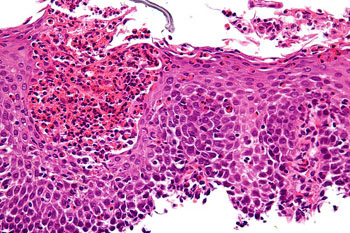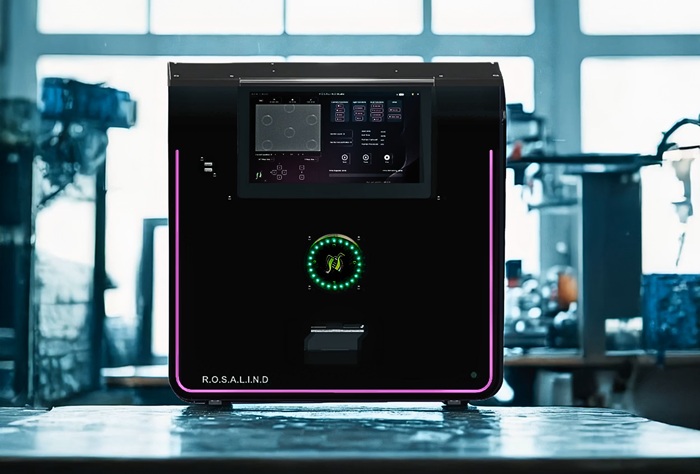Potential Noninvasive Biomarker of EoE Disease Activity Identified
|
By LabMedica International staff writers Posted on 24 May 2016 |

Image: A micrograph of eosinophilic esophagitis (EoE), H&E stain. Characteristic features are present: Abundant eosinophils – criteria vary; one common definition is: > 20 eosinophils/0.24 mm2; Papillae are elongated; papillae reach into the top 1/3 of the epithelial layer; Basal cell hyperplasia; > 3 cells thick or >15% of epithelial thickness; Spongiosis (Photo courtesy of Michael Bonert / Wikimedia).
Researchers have identified a potential blood-based marker of disease activity for the severe and often painful food allergic disease eosinophilic esophagitis (EoE) – possibly leading to a blood test, which could spare EoE patients, often children, the discomfort and risk of the currently used invasive endoscopic monitoring procedures.
Researchers at the Cincinnati Center for Eosinophilic Disorders (CCED) of Cincinnati Children’s Hospital Medical Center (Cincinnati, OH, USA) led the study. “Adults and children with EoE can be on highly restricted diets of formula alone or only a few foods,” said Patricia C. Fulkerson, MD, PhD, senior study author, “One of the major obstacles to families participating in studies to introduce foods back into the child’s diet is the need for endoscopy after each food is tried to see whether or not it triggers disease activity.”
The disease activity of EoE is currently monitored using peak esophageal eosinophil count, which requires endoscopy to collect esophageal tissue biopsies. People with EoE, a lifelong disease, must continue monitoring disease activity, even after effective treatment with restricted diets or steroids. Treatment changes, such as reintroducing a single food, require additional endoscopic exams to assess for disease flare-ups.
Prior research has demonstrated that testing blood of EoE patients is not a clinically useful indication of active disease because eosinophil levels in blood do not correlate well with levels in the esophagus. This led the team to investigate a precursor cell to eosinophils, a lineage-committed eosinophil progenitor (EoP), as a potential marker. They found elevated EoP levels in the blood of pediatric patients with active EoE disease, suggesting a promising, blood-based marker.
The authors emphasize that additional research is needed to validate the marker before routine clinical use. “This clinical study is the first to investigate EoP levels in patients with EoE and identifies a potential new noninvasive biomarker,” said study author Vincent A. Mukkada, MD, physician at Cincinnati Children’s and CCED member, “This work is an essential step toward improving outcomes for patients with EoE. It will be followed by repeated testing of more patients and with sequential measurements of EoP levels in the same patient during different disease states.”
Allergic diseases have been on the rise over the past 20 years. The CCED team has previously reported that incidence of EoE is estimated at 1 of 1,000 people. Their research has also shown that EoE is caused by a combination of genetic and environmental factors, and is primarily mediated by an immunologic response to foods. The hallmark of EoE is swelling and inflammation in the esophagus, accompanied by high levels of eosinophils.
The study, by Morris DW et al, was published May 16, 2016, in the Journal of Allergy and Clinical Immunology.
Related Links:
Cincinnati Children’s Hospital Medical Center
Researchers at the Cincinnati Center for Eosinophilic Disorders (CCED) of Cincinnati Children’s Hospital Medical Center (Cincinnati, OH, USA) led the study. “Adults and children with EoE can be on highly restricted diets of formula alone or only a few foods,” said Patricia C. Fulkerson, MD, PhD, senior study author, “One of the major obstacles to families participating in studies to introduce foods back into the child’s diet is the need for endoscopy after each food is tried to see whether or not it triggers disease activity.”
The disease activity of EoE is currently monitored using peak esophageal eosinophil count, which requires endoscopy to collect esophageal tissue biopsies. People with EoE, a lifelong disease, must continue monitoring disease activity, even after effective treatment with restricted diets or steroids. Treatment changes, such as reintroducing a single food, require additional endoscopic exams to assess for disease flare-ups.
Prior research has demonstrated that testing blood of EoE patients is not a clinically useful indication of active disease because eosinophil levels in blood do not correlate well with levels in the esophagus. This led the team to investigate a precursor cell to eosinophils, a lineage-committed eosinophil progenitor (EoP), as a potential marker. They found elevated EoP levels in the blood of pediatric patients with active EoE disease, suggesting a promising, blood-based marker.
The authors emphasize that additional research is needed to validate the marker before routine clinical use. “This clinical study is the first to investigate EoP levels in patients with EoE and identifies a potential new noninvasive biomarker,” said study author Vincent A. Mukkada, MD, physician at Cincinnati Children’s and CCED member, “This work is an essential step toward improving outcomes for patients with EoE. It will be followed by repeated testing of more patients and with sequential measurements of EoP levels in the same patient during different disease states.”
Allergic diseases have been on the rise over the past 20 years. The CCED team has previously reported that incidence of EoE is estimated at 1 of 1,000 people. Their research has also shown that EoE is caused by a combination of genetic and environmental factors, and is primarily mediated by an immunologic response to foods. The hallmark of EoE is swelling and inflammation in the esophagus, accompanied by high levels of eosinophils.
The study, by Morris DW et al, was published May 16, 2016, in the Journal of Allergy and Clinical Immunology.
Related Links:
Cincinnati Children’s Hospital Medical Center
Latest Pathology News
- Rapid Low-Cost Tests Can Prevent Child Deaths from Contaminated Medicinal Syrups
- Tumor Signals in Saliva and Blood Enable Non-Invasive Monitoring of Head and Neck Cancer
- Common Health Issues Can Influence New Blood Tests for Alzheimer’s Disease
- Blood Test Formula Identifies Chronic Liver Disease Patients with Higher Cancer Risk
- Tunable Cell-Sorting Device Holds Potential for Multiple Biomedical Applications
- AI Tool Outperforms Doctors in Spotting Blood Cell Abnormalities
- AI Tool Rapidly Analyzes Complex Cancer Images for Personalized Treatment
- Diagnostic Technology Performs Rapid Biofluid Analysis Using Single Droplet
- Novel Technology Tracks Hidden Cancer Cells Faster
- AI Tool Improves Breast Cancer Detection
- AI Tool Predicts Treatment Success in Rectal Cancer Patients
- Blood Test and Sputum Analysis Predict Acute COPD Exacerbation
- AI Tool to Transform Skin Cancer Detection with Near-Perfect Accuracy
- Unique Immune Signatures Distinguish Rare Autoimmune Condition from Multiple Sclerosis
- Simple Optical Microscopy Method Reveals Hidden Structures in Remarkable Detail
- Hydrogel-Based Technology Isolates Extracellular Vesicles for Early Disease Diagnosis
Channels
Clinical Chemistry
view channel
POC Breath Diagnostic System to Detect Pneumonia-Causing Pathogens
Pseudomonas aeruginosa is a major cause of hospital-acquired and ventilator-associated pneumonia, particularly in lung transplant recipients and patients with structural lung disease. Its ability to form... Read more
Online Tool Detects Drug Exposure Directly from Patient Samples
Doctors often rely on patient interviews and medical records to determine what medications a person has taken, but this information is frequently incomplete. People may forget drugs they used, take over-the-counter... Read moreMolecular Diagnostics
view channel
DNA Detection Platform Enables Real-Time Molecular Detection
A next-gen DNA detection platform enables real-time molecular detection by detecting nucleic acids directly without enzymes or thermocyclers, thereby slashing costs, reducing complexity, and boosting reliability... Read more
STI Molecular Test Delivers Rapid POC Results for Treatment Guidance
An affordable, rapid molecular diagnostic for sexually transmitted infections (STIs) has the potential to be globally relevant, particularly in resource-limited settings where rapid, point-of-care results... Read moreHematology
view channel
MRD Tests Could Predict Survival in Leukemia Patients
Acute myeloid leukemia is an aggressive blood cancer that disrupts normal blood cell production and often relapses even after intensive treatment. Clinicians currently lack early, reliable markers to predict... Read more
Platelet Activity Blood Test in Middle Age Could Identify Early Alzheimer’s Risk
Early detection of Alzheimer’s disease remains one of the biggest unmet needs in neurology, particularly because the biological changes underlying the disorder begin decades before memory symptoms appear.... Read more
Microvesicles Measurement Could Detect Vascular Injury in Sickle Cell Disease Patients
Assessing disease severity in sickle cell disease (SCD) remains challenging, especially when trying to predict hemolysis, vascular injury, and risk of complications such as vaso-occlusive crises.... Read more
ADLM’s New Coagulation Testing Guidance to Improve Care for Patients on Blood Thinners
Direct oral anticoagulants (DOACs) are one of the most common types of blood thinners. Patients take them to prevent a host of complications that could arise from blood clotting, including stroke, deep... Read moreMicrobiology
view channel
Breakthroughs in Microbial Analysis to Enhance Disease Prediction
Microorganisms shape human health, ecosystems, and the planet’s climate, yet identifying them and understanding how they are related remains a major scientific challenge. Even with modern DNA sequencing,... Read more
Blood-Based Diagnostic Method Could Identify Pediatric LRTIs
Lower-respiratory tract infections (LRTIs) are a leading cause of illness and death worldwide, and pneumonia is the leading infectious cause of death in children under five, claiming the lives of over... Read morePathology
view channel
Rapid Low-Cost Tests Can Prevent Child Deaths from Contaminated Medicinal Syrups
Medicinal syrups contaminated with toxic chemicals have caused the deaths of hundreds of children worldwide, exposing a critical gap in how these products are tested before reaching patients.... Read more
Tumor Signals in Saliva and Blood Enable Non-Invasive Monitoring of Head and Neck Cancer
Head and neck cancers are among the most aggressive malignancies worldwide, with nearly 900,000 new cases diagnosed each year. Monitoring these cancers for recurrence or relapse typically relies on tissue... Read more
Common Health Issues Can Influence New Blood Tests for Alzheimer’s Disease
Blood-based tests for Alzheimer’s disease are transforming diagnosis by offering a simpler alternative to spinal taps and brain imaging. However, many people evaluated at memory clinics also live with... Read more
Blood Test Formula Identifies Chronic Liver Disease Patients with Higher Cancer Risk
Chronic liver disease affects millions worldwide and can progress silently to hepatocellular carcinoma (HCC), one of the deadliest cancers globally. While surveillance guidelines exist for patients with... Read moreTechnology
view channel
Machine Learning Models Diagnose ALS Earlier Through Blood Biomarkers
Amyotrophic lateral sclerosis (ALS) is a rapidly progressive neurodegenerative disease that is notoriously difficult to diagnose in its early stages. Early symptoms often overlap with other neurological... Read more
Artificial Intelligence Model Could Accelerate Rare Disease Diagnosis
Identifying which genetic variants actually cause disease remains one of the biggest challenges in genomic medicine. Each person carries tens of thousands of DNA changes, yet only a few meaningfully alter... Read moreIndustry
view channel
BD and Penn Institute Collaborate to Advance Immunotherapy through Flow Cytometry
BD (Becton, Dickinson and Company, Franklin Lakes, NJ, USA) has entered into a strategic collaboration with the Institute for Immunology and Immune Health (I3H, Philadelphia, PA, USA) at the University... Read more








 (3) (1).png)











